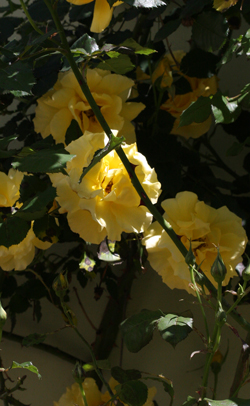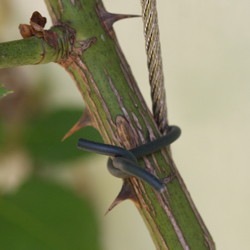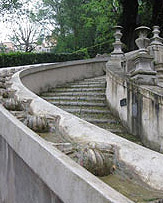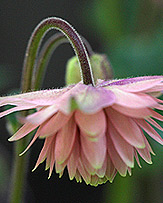
Pruning Climbing Roses
Getting the most out of climbing roses involves pruning as well as selecting the right rose for the right position. Pruning is the most important aspect of rose care and as growth habit varies, so general 'growing instructions' can sometimes be misleading. Training and pruning are also essential for good rose growth and flower production in climbing roses.
The Basics of Pruning Climbing Roses
Pruning Climbing Roses is not difficult if you follow a few basic guidelines. Climbing Roses need to be pruned to control growth, to keep the plant healthy and to promote flowering. Rose Pruning involves control of two types of growth, the main canes which go back to or very close to the base of the plant, and the laterals which are the ones that produce flowers. The main canes form the structure and need to be healthy and preferably not pruned to harshly.
Different Climbing Roses require different techniques
Vigorous Climbers for large spaces
For example some climbing roses are vigorous, this includes many of the David Austins, The Floribundas and of course the Ramblers. This means that they will not be suited to smaller arches.
Examples are Peace, Queen Elizabeth, Gold Bunny, and Banksia Lutea.
These will require more pruning to keep them in shapeClimbing Roses for small arbours
Others are far less vigorous, such as the pink flowering 'China Doll' and 'Guy Savoy'. These smaller varieties are better suited to small arbours and the like. Unless you are buying from a reputable specialist rose nursery, advice can sometimes be, 'what the nursery thinks you want to hear', 'rather than the fact', so research well before buying. The right climber for the right position.A vigorous climber on a small arch will quickly climb to the top and the flowers will all be at the top as well. Probably not what you are after. So give a little thought to the eventual size of the plant. A climbing rose, such as 'Gold Bunny' (pictured above right) is a profilific flowering rose when pruned correctly.
Training and Pruning go hand in hand.
Training your rose. Many climbing roses will also not flower well in the first year, this is normal, let the rose grow upwards and after this you can begin to train and espalier. Although canes can easily be bent and arched it is essential not to tie the tip of the can below horizontal, this will cause poor growth.
Do you need to Prune Water Shoots
Water shoots are another type of grow th that often cause confusion. A water shoot is a vigorous new growth from low on the plant, but always above the graft. It us the future of the plant and needs to be cared and nurtured. It is best to to leave these until they harden of a little before trying to train them. Bending new water shoots can cause then to break away at the base, and you have then lost the important new growth and future structure.
Gradually bend the water shoot to the desired angle, a little at a time. After you new shoot has settled in you can consider removing one of the old canes.

Supporting you Climbing Rose
It is important to remember that climbing roses are vigorous growers, they do not need to be pruned as heavily as othe r roses. And certainly no vigourous or hard pruning until the rose is intuits 2nd or 3rd year inn the garden. Always, tie you roses to supports. We pr efer to use wires and rose ties (see picture right)
Trellis and Roses are not a good mix.
Weaving them through a trellis will make it almost impossible to prune. The light timber lattice sold in many stores is not really much good as a long term support. Look to use wires, steel mesh attached to a fence ot to posts.
Spacing your climbing rose
As a rule try to espalier a rose at around 18 - 20 cm between horizontals. Try to set the wires 10 - 15 cm from the wall. This allows good airflow and makes them easier to prune.
Of course you can also grow climbing roses as a pillar. Train the canes gradually higher up the pillar with each new one. Prune the tip of the cane to promote flowers lower down.
Why Prune Climbing Roses?
Climbing Roses will keep growing (and flowering) if they are not pruned, so why prune a climbing roses at all? The simple answer is that unpruned roses will not flower as much as pruned roses. Secondly unpruned climbing roses tend to lose shape and become a little untidy. Left unpruned the job of pruning a climbing rose can be a big task.
Pruning a Climbing Rose basic tools.
The essential tools are a pair of good quality, clean sharp secateurs, a good pruning saw or pair of loppers is also advisable.
- Why clean? to prevent disease.
- Why sharp? So that cuts are clean
- Why good quality? A good quality pair of secateurs will be easier to keep sharp and will last a lot longer than a cheap pair.
Basic elements of pruning a climbing rose.
- All Climbing roses flower best on growth that was produced during the previous growing season.
- Climbing roses will flower more prolifically on horizontal growth than vertical growth.
So what we are trying to do is to encourage new growth, but not remove all of last years growth, and to prune so that we have horizontal growth. This will require training, as well as pruning.
Newly planted climbing roses need very little pruning, they should be dead headed and trained so that horizontal growth is encouraged, this is the case for two - three years.
How to prune an established climbing rose.
Prune climbing roses after the last flowers have faded, late autumn or early winter.
Remove any suckers from below the graft. Remove any dead or really old wood. Cut back main stems to 5 or 6 but try not to prune the remaining canes to hard if at all. Remove the oldest ones. In general cut back other growth by about 1/3. Secure new growth to the support frame with rose ties, NOT by weaving the stems through a trellis. Weaving any climbing plant through a trellis or similar structure make future pruning much more difficult. Fertilize and mulch after pruning for a flying start to the next flowering season.
Climbing Rose Care in Windy Areas
Growing Climbing Roses in windy conditions can be a problem, roses do not really like the wind, and grafted roses pose extra problems.
One of the main issues is that wind consistently moves the plant, this causes poor root development as they are rocked in the ground. Wind also causes pressure on any graft, weeping roses are a classic, where the whole top can be be blown off unless supported, climbers can also suffer this fate.
This does not mean you need to give up on growing roses in windy areas, you just need to take a few extra measures.
- Choose a ¬?strong growing sturdy rose.¬?
With wind it becomes a matter of the best protection, holding the rose still so the roots do not move, ¬?and the sunniest position.
- Best to plant so that the rose is not facing the prevailing wind. So its parallel to it... if possible
- Stake the plant firmly when you first plant it to prevent the roots being moved by the wind. A permanent stake is required as well as the climbing frame. In very windy conditions 2 - 3 stakes around the stem with ties that are a little flexible and soft on the rose stem.
- You also need to have avery good support system.....(climbing frame)
- Ideally against a wall, that stops the wind, yet gives sun..
- In an ideal world you would create a windbreak with other plants. A hedge to stop the wind, or maybe create a 'garden room' with hedges around it and the roses growing within.
All of this is not always possible so
- Make sure the rose has excellent support and is firmly staked. 2 -3 stakes around the stem so it will not rock in the wind.
As many of the other factors as possible.
You may also be interested in
- Pruning Lavender
- Pruning Artemisia Powis Castle
- Pruning Clematis
- Pruning Climbing Roses
- Pruning Roses
- Pruning Hydrangeas
You May Also Like
MOWERS-ONLINE.CO.UK Pole hedge trimmers and pole pruners are ideal for tackling those hard to reach climbing roses. View our large stock of these pruners online. Pole Pruners |




